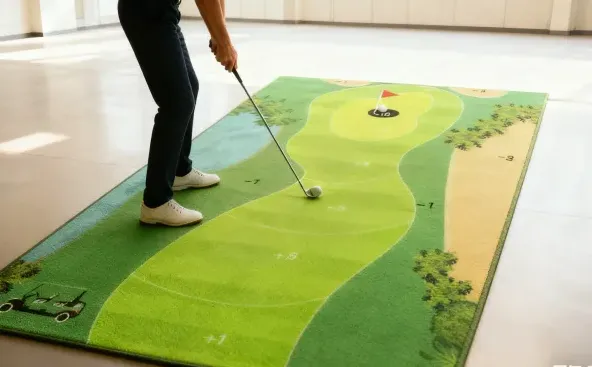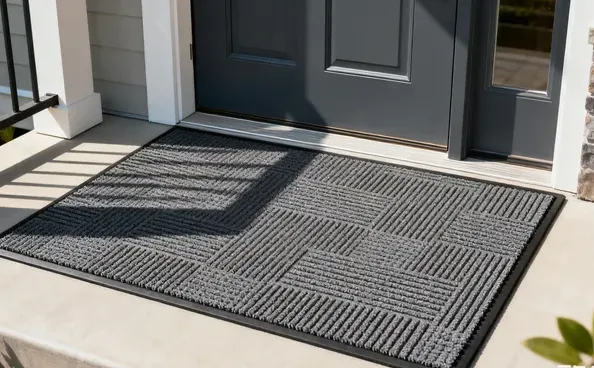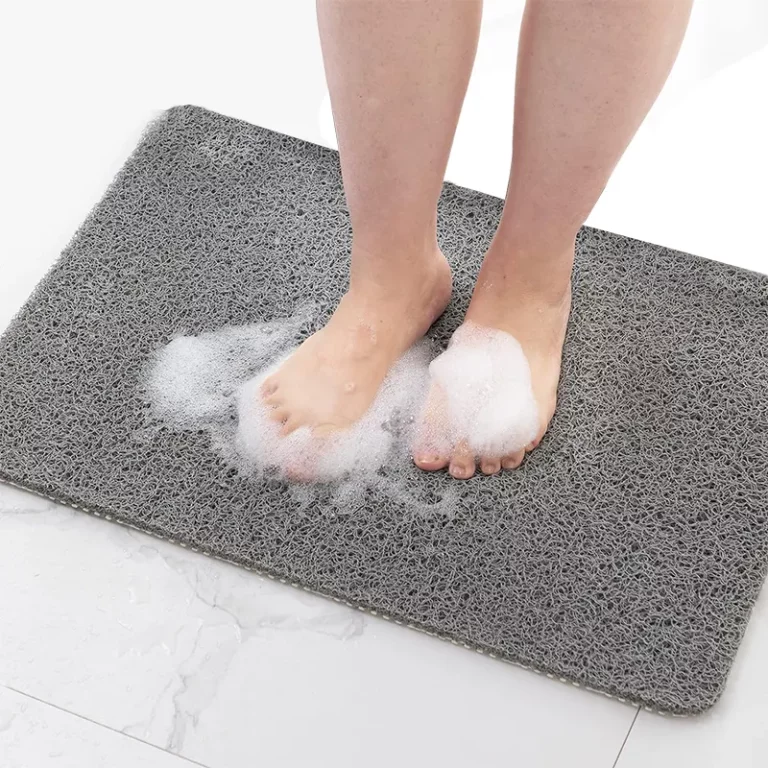I once walked indoors after heavy rain and nearly slipped on a soaked rug. It startled me. I needed something that could stay dry and stable in wet conditions.
A water-resistant outdoor doormat is the best choice for a busy entryway. It dries quickly, traps moisture, and remains secure underfoot. Look for sturdy synthetic materials with raised textures. This setup prevents soggy surfaces and lowers the risk of slips.
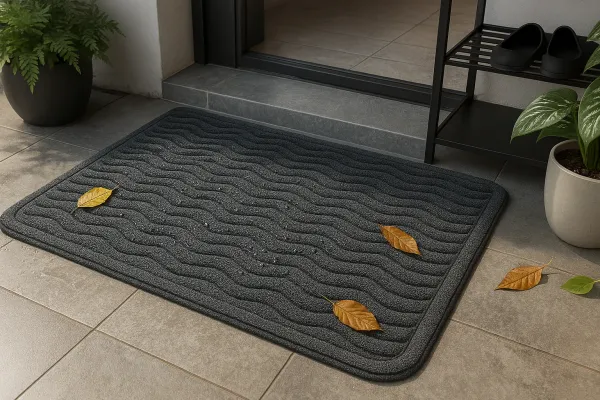
I remember the relief I felt when I found a rug that didn’t stay soggy for hours. It kept my floors clean and safe. Let’s examine some related questions about choosing the perfect outdoor doormat.
What doormat doesn’t get waterlogged?
I once bought a plush mat because it looked nice. But it soaked up water like a sponge and never dried quickly. It made me realize how essential quick-drying capabilities are.
A doormat with water-resistant, fast-drying fibers1 won’t get waterlogged. Many outdoor mats use synthetic blends such as polypropylene or PVC. They repel moisture and dry faster than cotton or jute.
How to Avoid Waterlogged Doormats
I used to think all doormats would handle rain. Then I saw puddles collecting on a mat that stayed soggy long after the storm ended. Over time, that damp environment led to mildew and unpleasant smells. I realized I needed a different approach. Let’s break down why some doormats stay drenched while others remain fresh:
Materialzusammensetzung
- Polypropylen
This synthetic fiber dries rapidly and resists mold. Water slips off its surface instead of soaking in. I like polypropylene-based mats because they’re easy to shake clean. - PVC (Vinyl)
PVC mats often have ridges or open weaves that let water flow through rather than pool on top. This design also traps mud and debris, which reduces mess. - Gummi
Sturdy rubber mats repel moisture entirely. Some rubber mats feature holes or grooves that channel water away, preventing large puddles from forming.
Construction Style
- Raised Patterns
Elevated designs create air pockets, improving drainage. When water lands on the mat, it flows into channels or holes and evaporates more quickly. - Dual-Layer Systems
Some doormats feature a top layer where debris collects and a bottom layer that catches water. That prevents the doormat’s surface from getting saturated.
Placement & Maintenance
- Position your outdoor mat under a slight overhang if possible. Direct rainfall won’t accumulate as much on the rug. If that isn’t an option, pick a mat with large drainage gaps.
- Shake or rinse the mat regularly to remove dirt and leaves. Debris can trap moisture, prolonging dampness.
- Hanging the mat in direct sunlight after a heavy storm helps it dry faster. UV rays assist in killing off mildew or algae that might develop on a perpetually damp surface.
(An Extra Tip)
If your region experiences frequent rain, consider investing in a mat that has a strong rubber backing but a woven synthetic top. This design not only repels water from above but also prevents moisture seeping in from beneath.
Choosing a water-resistant doormat that channels water away keeps your entryway welcoming instead of soggy. I noticed that after switching to a polypropylene mat with a raised pattern, my porch dried out quicker. My family tracked less mud indoors, and we felt more secure stepping onto a stable, non-squishy surface.
What type of rug is best for an entryway?
I used to believe any pretty rug would look fine by the door. Then, I spent ages scrubbing muddy footprints, and the rug never fully dried. I realized function matters just as much as appearance.
A rug made from durable synthetics like polypropylene or PET is ideal for an entryway. These materials withstand heavy foot traffic, repel moisture, and clean up easily with a quick shake or rinse.
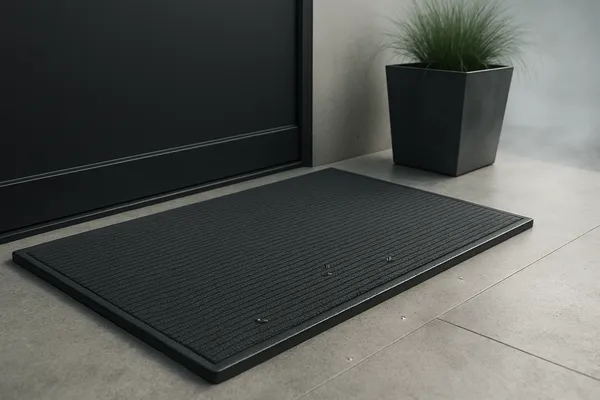
Selecting the Perfect Entryway Rug
When it comes to entryways, rugs do double duty—catching debris from outside and adding a welcoming touch. I once chose a delicate indoor rug, only to watch it fray under constant foot traffic. After that, I focused on materials and designs crafted for durability. Let’s break down key factors:
1. Material Durability
- Polypropylen2
This material resists stains, dries rapidly, and handles sun exposure without fading fast. An ideal pick for front doors that see unpredictable weather. I also like that polypropylene doesn’t hold onto moisture or smells. - PET (Recycled Polyester)
PET is an eco-friendly alternative crafted from recycled plastic bottles. It’s strong, colorfast, and stands up to repeated cleaning. If you want something sustainable, a PET rug might be a great match. - Nylon
Known for resilience, nylon rugs are less common outdoors but can handle heavy traffic near the door inside. Some have water-resistant coatings too.
2. Weave and Thickness
- Low-Pile Construction
Entryway rugs should be thin enough to fit under doors without bunching. Low pile also traps fewer particles, making cleaning easier. - Tight Weave
A dense weave discourages dirt from getting stuck deep. This style also reduces snagging from shoes or paws.
3. Backing and Grip
- Rubber or Latex Backing
Nothing is worse than a rug sliding when you step on it. A slip-resistant base keeps it firmly in place. Some backings also prevent moisture from seeping through to the floor below. - Breathable Undersides
Certain rug designs allow airflow underneath, helping the rug dry faster after rain or snow.
4. Style and Color
I prefer rugs with subtle patterns that mask dirt. Earthy tones or dark grays hide footprints better than light hues. If you want more flair, pick a design with multiple colors to camouflage daily scuffs.
Here is a small table to compare common entryway rug materials:
| Material | Wasserbeständigkeit | Einfache Reinigung | Haltbarkeit | Ideal Placement |
|---|---|---|---|---|
| Polypropylen | Hoch | Easy (Hose/Shake) | Hoch | Covered or uncovered door areas |
| PET Polyester | Hoch | Easy (Hose/Shake) | Hoch | Indoor/outdoor combos |
| Nylon | Mäßig | Fleckenentfernung | Hoch | Mostly indoor, heavier traffic |
| Baumwolle | Niedrig | Needs frequent washing | Medium | Dry climates or decorative spots |
(Quick Suggestion)
If you have an active household or live in a place with four distinct seasons, choose an outdoor-specific rug or doormat that can handle dirt, salt, and moisture. That rug will save you countless cleaning sessions and keep your entry tidy.
Once I switched to a polypropylene doormat, I noticed fewer muddy tracks on my floor. The rug also looked new even after months of stepping in from the rain or snow. A sturdy entryway rug is a small but worthwhile investment for any busy home.
Should you put a door mat outside?
I once relied on a tiny mat inside the doorway, but it didn’t capture enough debris. My floors stayed grimy. I wondered if I needed an Außenmatte3 too.
Yes, placing a door mat outside is a good idea. It helps scrape off dirt, mud, and moisture before anyone even steps inside. This extra barrier keeps your floors cleaner and reduces slipping hazards.
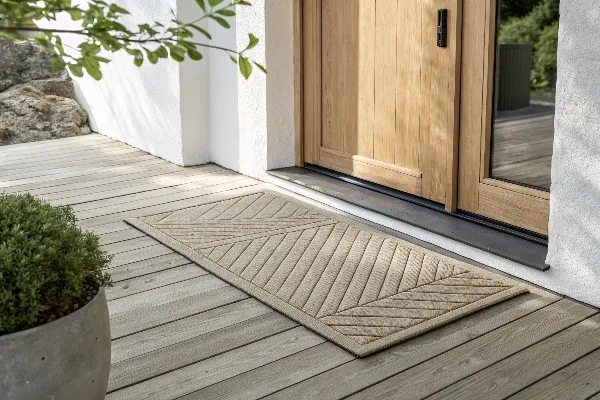
The Value of an Outdoor Doormat
For many years, I put all my faith in an indoor rug. Each time someone entered with wet or muddy shoes, that interior rug was overwhelmed. The result? Stains that never fully vanished. Only after adding an outdoor mat did I see a major improvement. Let’s unpack why an exterior mat matters:
1. First Line of Defense
An outdoor mat serves as a place to wipe off the heaviest debris—dirt clumps, wet leaves, or gravel. By the time someone reaches your indoor mat, their shoes carry far less muck.
2. Weather-Friendly Materials
Outdoor doormats are built to withstand rain, sun, and temperature changes. I’ve used polypropylene or rubber mats that don’t fade in direct sunlight and remain intact during freezing winters. Some even have draining holes so puddles don’t form on top.
3. Safety and Stability
Outside mats typically have a heftier design with slip-resistant backings or integrated ridges. When placed on a porch or front step, they’re less prone to shifting around. If you live somewhere windy, select a heavier mat or weigh it down at the corners.
4. Easier Maintenance
Outdoor mats are simpler to clean. A quick shake or a hose-down usually does the job. Any debris they collect remains outside, so you don’t have to worry about dusting or vacuuming as often. This convenience is a big plus if you have a busy schedule.
(Personal Insight)
I keep a mat outside and another right inside the door. The outside one takes care of large chunks of mud or snow, and the inside one deals with leftover moisture. This two-step mat system drastically cut down on cleaning time. My floors no longer look like a mud track after every rainy day.
The bottom line: putting a mat outside is a practical move if you want to minimize interior mess. Combined with a good indoor rug, it forms a complete shield against weather-related grime.
Are outdoor rugs really waterproof?
I used to doubt that any rug could truly handle constant rain without issues. But I tried an “outdoor waterproof rug” and found it surprisingly durable and dry.
Yes, many outdoor rugs are made from waterproof or water-resistant materials like polypropylene, PVC, or rubber. They’re designed to repel moisture, resist mildew, and endure frequent wet conditions.
Understanding Outdoor Waterproof Door Mats
I once left an “indoor/outdoor” mat on my porch during a heavy downpour. After the storm, I saw no signs of sogginess or mold. That experience convinced me that certain materials truly excel in wet conditions. Let’s dissect how they do it:
1. Protective Fibers and Coatings
- Polypropylen
This synthetic fiber doesn’t absorb water like cotton or wool. It dries quickly after rain. I can even tip it slightly and watch water roll off. - PVC (Vinyl)
Vinyl-based doormats shrug off moisture. Some have raised textures, letting water drain away rather than soak in. - Gummi
A rubber mat is almost entirely waterproof. Water can’t penetrate, so the mat remains structurally sound for years.
2. Mildew and Mold Resistance
Many waterproof outdoor mats are chemically treated or naturally mold-resistant. This matters because standing water and organic debris can breed bacteria. If you’ve ever lifted a soggy rug and smelled a musty odor, you know how unpleasant mold can be. A truly waterproof rug drastically reduces that risk by letting moisture evaporate or drain off.
3. Maintenance Routines
- Rinsing
A quick hose-down removes surface dirt, pollen, or leaves. The mat doesn’t stay damp for long. - Sunlight Drying
Placing the mat in direct sunlight helps kill lingering microbes. Because it’s waterproof, leftover moisture typically vanishes fast. - Occasional Scrubbing
If grime builds up, use mild soap and a soft brush. Because the rug doesn’t soak in water, it’s easy to rinse thoroughly.
(Little Extra Tip)
If you’re uncertain about a rug’s waterproof claims, look for “water-resistant” or “all-weather” on the label. Genuine waterproof rugs often specify outdoor usage explicitly and highlight features like “mold/mildew resistance” or “quick-dry technology.” Reading buyer reviews can also provide insight into real-world performance.
As an added bonus, waterproof outdoor doormats handle extreme temperature swings better. They don’t crack in cold weather or warp under intense heat. Investing in a sturdy, waterproof mat pays off if your porch or entry gets battered by the elements. You’ll find that these mats not only hold up but maintain their looks for multiple seasons. I now rely on them year-round, knowing they protect my floors from moisture and daily dirt.
Abschluss
A water-resistant outdoor doormat is your best defense against tracked-in moisture. With robust materials like polypropylene or rubber, these mats stay functional in rain or shine, keeping entryways dry and inviting.
-
Explore this link to understand how these fibers can enhance your doormat’s performance and longevity. ↩
-
Learn why polypropylene is favored for entryway rugs due to its durability, stain resistance, and quick drying properties, making it ideal for high-traffic areas. ↩
-
Explore the advantages of outdoor mats to keep your home cleaner and safer, especially in wet or muddy conditions. ↩


